Connecting inFlow to Shopify
Do you have an online store with Shopify? If so, you can reduce double entries by connecting inFlow to Shopify to update orders and products.
Before connecting
How does inFlow connect to Shopify?
When you connect your Shopify store to inFlow, you create a link that keeps both systems up to date with all orders and product information.
See below for a basic overview of how inFlow and Shopify will work together.
Shopify orders
- Shopify orders create an inFlow sales order, which you can use to manage the order’s fulfillment.
- inFlow will send shipping updates to the matching Shopify orders.
Shopify & inFlow products
- When products are updated in inFlow, that data will sync to your Shopify products.
- New products created in Shopify will also be made in inFlow. (New products made in inFlow cannot be created in Shopify)
- Product changes made in inFlow are sent to Shopify to keep products in both systems updated with the same details.
Pull and push workflow
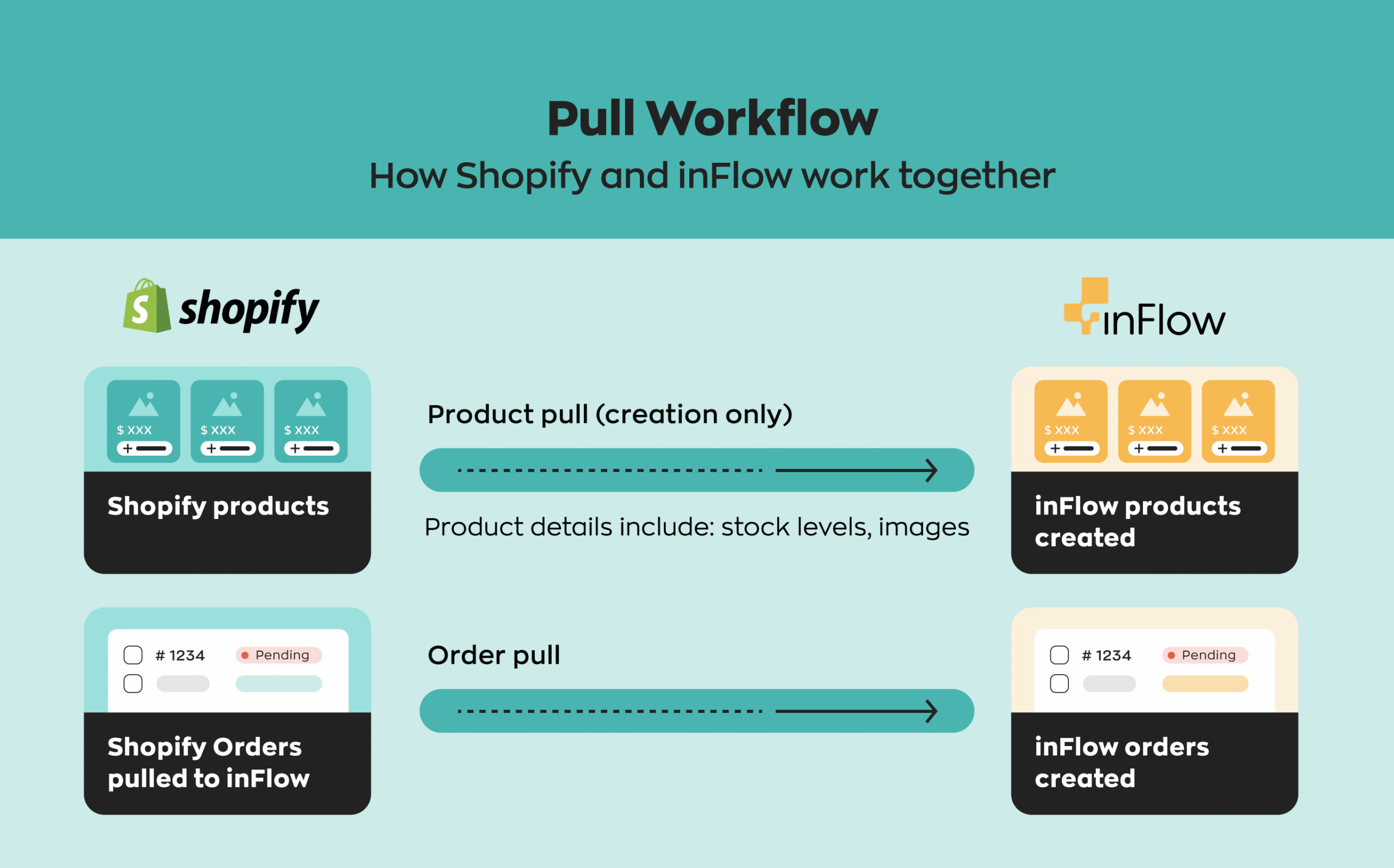
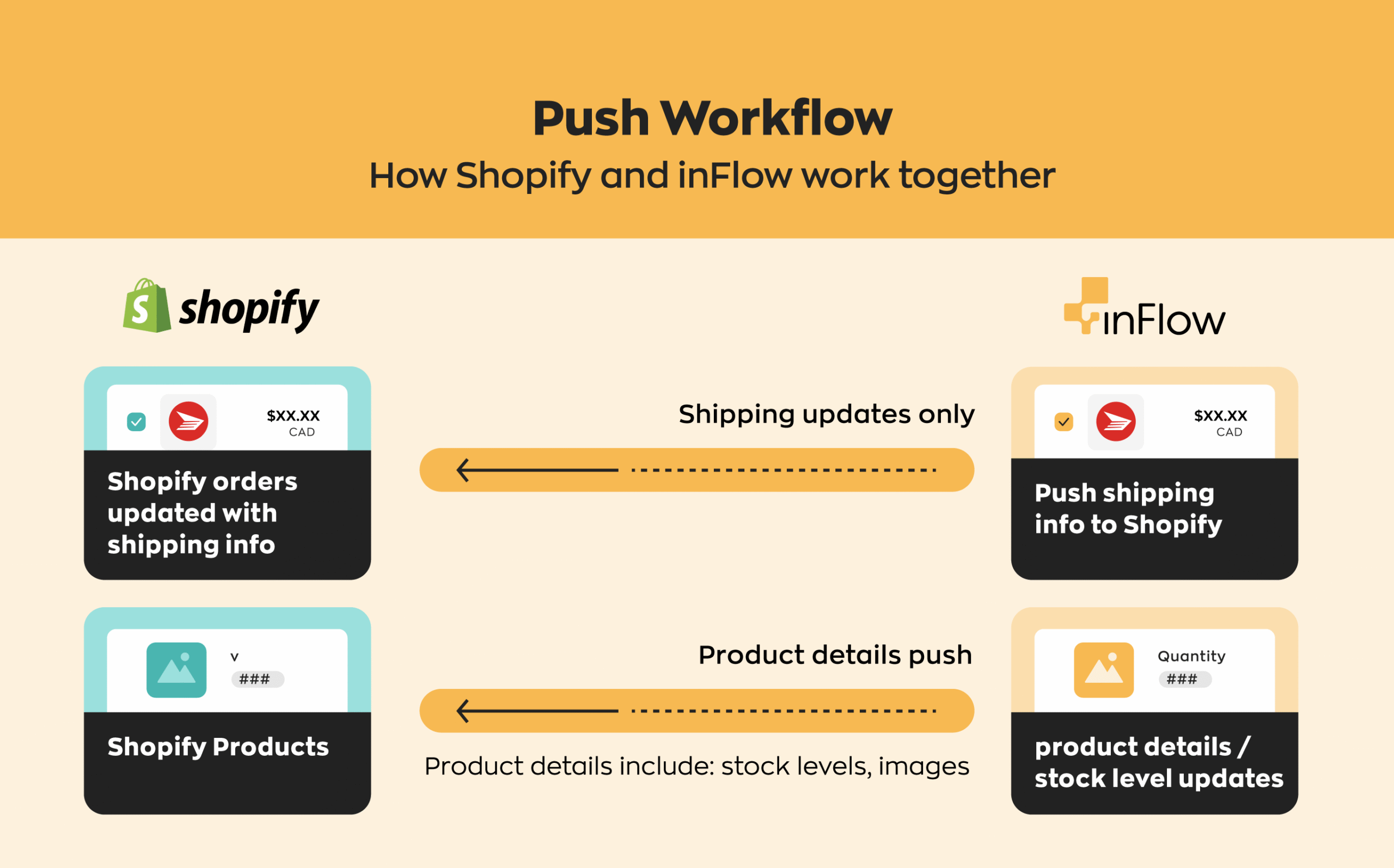
Before you connect
Below is some good-to-know information about inFlow and Shopify.
Product matching
If you have products in both inFlow and Shopify, the product SKUs in inFlow must exactly match those in Shopify. If there are no product SKUs in inFlow, the product names in inFlow must exactly match those in Shopify.
We recommend using SKUs in both inFlow and Shopify to reduce inaccuracies.
If you don’t have any products in inFlow, this integration lets you pull products from your Shopify store into inFlow.
Pricing Schemes
By connecting inFlow to Shopify, you’ll have the option for inFlow to update your product prices and send the updated prices to matching products in Shopify. For this to work, you’ll need to connect the Shopify Price (and the optional Compare at price) to a matching pricing scheme in inFlow.
If you don’t have pricing schemes in inFlow before connecting to Shopify, you can create them during the setup by clicking on +Pricing scheme. For more information on pricing, see this pricing scheme article.
Currencies
It’s recommended that inFlow and Shopify use the same default currency. If you’ll be accepting multiple currencies in Shopify, make sure the setting is active by following these Shopify steps.
Locations
When you connect Shopify to inFlow, you can select which inFlow location to use for order fulfillment and product inventory.
If you don’t have locations created in inFlow before connecting to Shopify, you can create them during the setup by clicking on +Location. If you prefer to add your locations before setting up, take a look at the inFlow tracking locations article.
When setting up, you can choose whether inFlow uses inventory from all your locations or a specific inFlow location to push product data to Shopify. It’s recommended that if you have multiple locations in Shopify, you select specific inFlow locations to avoid any inventory inaccuracies.
Turn off the order archiving setting in Shopify
inFlow can only pull orders from Shopify that are not archived. By default, this setting is inactive on regular Shopify stores, but in Shopify POS, it is enabled and must be turned off.
You can find details on how to turn off the archiving orders setting in this Shopify guide.
Connecting inFlow to Shopify
To connect inFlow to Shopify, you’ll need to access the Shopify App Store and your Shopify Store Admin settings.
- Log in to your Shopify store, and select the store you want to connect to inFlow.
- In Shopify, click on Apps, then search for “inFlow Connector”.
- A new tab or window will open, taking you to the Shopify App Store. Click on inFlow Connector.
- Click on Add app if it hasn’t already been installed. Then select Install app on the next screen.
- If you’re not logged into inFlow, you’ll be asked to log into your inFlow account.
- Once logged in, you may be redirected to a permissions screen if you’re connecting Shopify to inFlow for the first time. Click on Yes, Allow.
- You’ll be directed to the Shopify integration setup page.
- Click Connect for any shop location you wish to pull orders from and push inventory to (optional), along with the remaining settings.
Refer to the Setup tab for a complete guide on connecting inFlow to Shopify.
inFlow Connector Setup
Shopify webinar
Watch the webinar below to learn more about integrating inFlow with Shopify.
Locations
Once you’re in the inFlow Connector App settings, the first thing you’ll need to set up is the locations. This is to set which inFlow location(s) you’ll connect to your Shopify store location(s).
- You’ll see a list of your Shopify store locations. Click Connect to grant inFlow access to the locations you want.

- You can choose which inFlow location to connect to your Shopify store. Select either Connect to one location or Connect to all inFlow locations.

| Location option | Best if… |
| Connect to one location | You track multiple locations in Shopify. We recommend mapping each Shopify location to a single inFlow location for accurate inventory levels. |
| Connect to all inFlow locations | You’d like to push the total quantity available for all your products across all your inFlow locations to a Shopify location. |
If you don’t have all locations created in inFlow before connecting to Shopify, you can create them during the setup by clicking on +Location in the drop-down menus. This will create the location directly in inFlow from the inFlow Connector app.
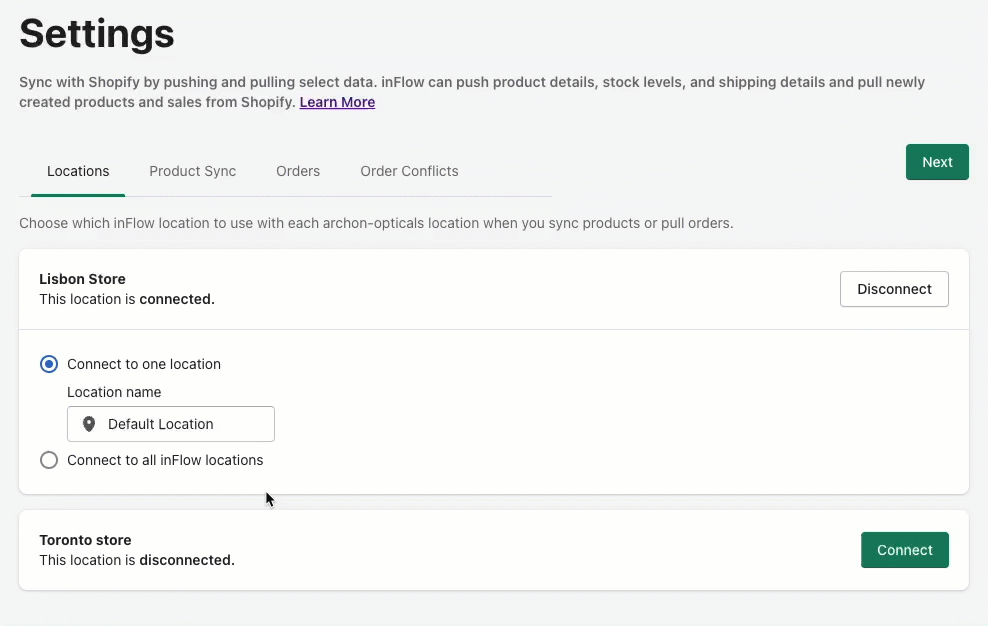
Note: If you haven’t personalized inFlow before setting up this integration, you can connect the Default location to connect to Shopify. At a later time, you can rename this location to match the name of your inventory location.
When done, click Next to continue to the Product Sync tab.
Product sync
On this tab, you can choose how inFlow should handle product updates for both inFlow and Shopify.
Pricing settings
The first setting in this section is the pricing settings. This is for connecting your Shopify prices to your inFlow pricing schemes*. This will apply to both pushing and pulling from Shopify.
*Pricing schemes are different pricing options such as retail, wholesale, etc. that you can add to your inFlow products.
- Price is what your products normally sell for in your Shopify store. In the drop-down menu, select a matching inFlow pricing scheme.
- Shopify also lets you show a discounted price. If you want to use this option, map the Compare at price to a different inFlow pricing scheme from the drop-down menu.

If you want to add more price options to inFlow, click the +Pricing scheme button to add product pricing from this setup screen.


Helpful inFlow pricing scheme articles:
- How to add pricing schemes to inFlow.
- How to import multiple product prices to pricing schemes.
- How to mass-adjust product prices for a pricing scheme. (inFlow Inventory for Windows only)
Push settings (inFlow to Shopify)
“Pushing” is the act of sending information from one system to another. In this case, data is sent from inFlow to Shopify to update products.
This means you can make changes to your products in inFlow, and inFlow will send those changes to Shopify. This will reduce the need for double-entry for updating your products in both systems.
inFlow can push stock levels, images, weight, dimensions, and pricing. To use this feature, toggle on the product details you want inFlow to push.

Note: inFlow will only update the quantity levels that match the products in the location(s) you’ve set in the Location tab.
Additional information
If a product isn’t found in Shopify
This is a setting designed to alert you about products that inFlow has but are missing in your Shopify store. You can choose Let me know or Don’t let me know. Take a look below for explanations for both options.
| Product push notification option | Best if… |
| Let me know | If all products in inFlow are also sold on your Shopify store. This will let you know that there’s a product in inFlow that needs to be created in Shopify. |
| Don’t let me know | If you only sell select products in inFlow on your Shopify store. Select Don’t let me know to avoid getting repeated messages about products in inFlow that are missing in Shopify. |
Note: inFlow isn’t able to create new products in Shopify.
Product pull settings (Shopify to inFlow)
“Pulling” is the act of getting information from another system. For example, inFlow will collect data from Shopify. This means new orders and products made in Shopify will be created in inFlow.
This pull setting can only be done once per product. After the product is pulled into inFlow, you can add more information to that product from the inFlow side, and if the product push settings are enabled, those changes will be sent to Shopify to keep everything up-to-date with products with a matching product name/SKU.
If you want inFlow to create products from Shopify, click on the Activate button under Pull settings. When this setting is active, the new Shopify products will be added to inFlow. This includes quantity available, images, barcode, weight, price, compare at price (optional), and cost.

Note: If you’re setting up Shopify with an empty inFlow database, you can use the pull option to add products from Shopify at the end of the setup.
Using FIFO/ LIFO & connecting to Shopify
When using FIFO or LIFO costing in inFlow, products pulled from Shopify won’t pull the product costs. The costs are only updated when a purchase or manufacture order is created in inFlow.
Updated product costs in inFlow can then sync back to Shopify based on the cost push settings. You will receive an alert when products are pulled without a cost.
Additional information
Which products will inFlow push to Shopify?
For inFlow to push product details, the product must exist in both systems. This means the product SKU in inFlow must be the same as the product SKUs in Shopify. If there is any difference, inFlow won’t be able to find the product in Shopify.
Can inFlow create products in Shopify?
inFlow doesn’t create new products in Shopify. If a new product is added to inFlow, the product will need to be added manually to Shopify.
If you make a new product in Shopify, the integration can pull the new product into inFlow, so you don’t have to manually add the product to both systems.
What product type will products pulled from Shopify be?
All products pulled from Shopify to inFlow were pulled as stocked products. If you want a product to have the product type of serialized, non-stocked, or service, you will have to create the product in inFlow first. Once made, create that product in Shopify with a matching SKU.
Click Next to proceed to the Orders tab.
Orders sync
This tab is where you can choose settings related to how Shopify orders are pulled into inFlow. inFlow will be able to pull only open/unfulfilled orders from the last 365 days.
Set Customer name from
This setting is where you can choose how you’d like the customer information to pull from Shopify to inFlow. Select one of the following options for how the customer name will display on inFlow sales orders.

Import order numbers
This setting is where you can set the naming for orders that are created from Shopify to inFlow. You can choose for the order numbers to pull: As is or Add prefix.
The prefix option lets you add the store name, should you wish to have a quick way to see which sales orders are created from Shopify and which have been made from inFlow directly.

Import orders into inFlow as
This setting determines how inFlow should import your orders.
- As is: inFlow will match the fulfillment status of the Shopify order.
- As Fulfilled: This will mark all pulled orders as fulfilled, regardless of their status in Shopify.

| Import order option | Choose if… |
| As is | Choose this option if your team wants to manage the processing and fulfillment of the order once it is in inFlow. If you want fulfillment updates to push from inFlow to the matching Shopify order. |
| As fulfilled | Use this option if you want to remove products from inventory as soon as the Shopify order is pulled into inFlow. If you don’t want to update the matching Shopify order with fulfillment changes. |
Push shipping information
Once inFlow pulls orders from Shopify, they’ll be processed and fulfilled in inFlow. When the order is processed, the shipping information will be sent to the matching sales order in Shopify.
To enable shipping updates, click on Activate

Click Next to proceed to Order conflicts.
Order conflicts
There are times when there could be differences between inFlow and Shopify, which can cause conflicts. You can set how inFlow will treat conflicts with the settings on this tab.

Tax conflicts
Can’t find a matching taxing scheme
The setting Can’t find a matching taxing scheme can occur if inFlow pulls a Shopify order that has different taxing settings (taxing schemes) than inFlow has. You can choose from the options below for how you’d like inFlow to handle this situation.
| Conflict options | What inFlow will do |
|---|---|
| Create the taxing scheme | With this option, the Shopify order won’t be pulled into inFlow but instead will show an error on https://app.inflowinventory.com/options/integrations. This option is best if you want to add the missing taxing information to inFlow, and inFlow will try to pull the order again. When the taxes have been added, inFlow will try to pull the Shopify order again to ensure accurate tax integration. |
| Add an adjustment line to the order | For this option, inFlow won’t try to create the taxes that are on the Shopify order in the created inFlow sales order. inFlow will create a line item on the sales order to add the funds that make up the tax amount. With this option, the order totals for the Shopify order and the inFlow sales order will match, but the taxing will be different. |
| Stop importing the order and give an error | With this option, the Shopify order won’t be pulled into inFlow but instead will show an error on https://app.inflowinventory.com/options/integrations. This option is best if you want to add the missing taxing information to inFlow, and inFlow will try to pull the order again. When the taxes have been added, inFlow will try to pull the Shopify order again for the taxing to pull into inFlow correctly. |
Pricing scheme conflicts
Can’t find a matching pricing scheme
In Shopify, there aren’t any pricing scheme settings like inFlow has. So, what inFlow will do is take a look at the currency that Shopify has on the order and match it with a pricing scheme with the same currency.
If inFlow has multiple pricing schemes that match the currency on the Shopify order, then inFlow will choose either the inFlow default of that currency or use the pricing scheme that is set on the inFlow customer record.
If there isn’t a matching currency/pricing scheme from Shopify to inFlow, you can choose from the following options for how you’d like inFlow to handle this situation.
| Conflict options | What inFlow will do |
|---|---|
| Create the pricing scheme | With this option, inFlow will create a pricing scheme that will match the currency from the Shopify order. It will be called an “Imported pricing scheme”. |
| Stop importing the order and give an error | With this option, the Shopify order won’t be pulled into inFlow, but instead will show an error on app.inflowinventory.com/options/integrations. This option is best if you want to add a matching pricing scheme to inFlow, and inFlow will try to pull the order again. When the order is pulled into inFlow correctly, then inFlow will use the new matching pricing scheme on the order. |
Customer record conflict
Can’t find a matching customer
When inFlow pulls orders from Shopify, it checks the customer name on the Shopify order to ensure a match in inFlow. If there isn’t a matching customer record, you can choose how you’d like inFlow to handle this conflict.
| Conflict options | What inFlow will do |
|---|---|
| Create the customer | With this option, inFlow will create a customer record that matches the customer from the Shopify order. |
| Stop importing the order and give an error | With this option, the Shopify order won’t be pulled into inFlow but instead will show an error on https://app.inflowinventory.com/options/integrations. This is where you can manually add the customer directly into inFlow and attempt to retrieve the order. When the order is pulled into inFlow correctly, then inFlow will use the new matching customer record on the order. |
inFlow and Shopify calculations
If the imported order total doesn’t match inFlow’s calculations
There are times when calculations between systems will yield a different result. Because of this, you can set how inFlow should handle these situations.
| Conflict options | What inFlow will do |
|---|---|
| Add an adjustment line to the order | With this option, the Shopify order won’t be pulled into inFlow, but instead will show an error on app.inflowinventory.com/options/integrations. This option is best if you prefer to review the conflict first. If you prefer, you can add the order to inFlow manually to bypass the calculation error. |
| Stop importing the order and give an error | With this option, the Shopify order won’t be pulled into inFlow but instead will show an error on app.inflowinventory.com/options/integrations. This option is best if you prefer to review the conflict first. If you prefer, you can add the order to inFlow manually to bypass the calculation error. |
Shopify setup complete
Once you’ve gone through all the tabs, you can click Complete. inFlow will now connect to your Shopify store going forward. When you want to proceed, click the Pull now button.
If you choose to pull products, then both products and Shopify orders (open and pending orders from the last 365 days) will be pulled to inFlow.

If you’re not pulling products to inFlow, click on the Pull now button to continue.

While your products and orders are pulling, you can close this window. When this process is complete, there will be a green checkmark on the Shopify logo in inFlow.

Additional information
I didn’t pull products when first setting up. Can I pull products from Shopify later?
Yes, once inFlow connects to Shopify, you can access the Pull now button from the inFlow Connector app.
Can I click the Pull now button again if I made updates to my products in Shopify?
No, the Pull now button only works once per SKU. If you click the Pull now button after the products have been made in inFlow, only new Shopify products will be created in inFlow. With product pull enabled, inFlow will continue to pull new products made in Shopify to inFlow for you.
We’d encourage you to make product updates in inFlow with the product push settings enabled. This will send product updates to your matching Shopify products.
Did you connect the wrong Shopify store to inFlow?
If you need to change which store is connected to inFlow, you can find full steps on how to remove a Shopify store in the How to disconnect Shopify from inFlow section of the Customization tab.
Customization
Edit Shopify integration settings
Once you’ve connected inFlow to Shopify, you can make changes to the integration settings at any time. To do this, you’ll repeat similar steps to the initial setup.
- With an Admin account, go to https://app.inflowinventory.com/options/integrations.
- Click on the Shopify icon.
- Click on the blue arrow next to your Shopify store name.
- This will redirect you to the inFlow Connector app within your Shopify store.
From here, you can make changes to the settings. Click on the Save button when done.

Connecting to multiple Shopify stores
If your team has multiple Shopify stores, you can connect them all to inFlow. Each Shopify store counts as one integration to inFlow. Be sure to check how many integrations your inFlow plan can have before continuing.
How to connect another Shopify store to inFlow
To connect to another store, you can repeat the same steps as you did for connecting the first store by using the inFlow Connector app in the Shopify app store.
- Log in to your Shopify store, and select the store you want to connect to inFlow.
- In Shopify, click on Apps and search for “inFlow Connector.”
- A new tab or window will open, taking you to the Shopify App Store. Click on inFlow Connector.
- Click on Add app if it hasn’t already been installed. Then select Install app on the next screen.
- You’ll be directed to the Shopify integration setup page. From here, click on Manage settings.
- Click Activate for any shop locations and go through all the setup sections.
How to disconnect Shopify from inFlow
If you ever need to disconnect your Shopify store from inFlow, follow the steps below.
- With an Admin account, go to https://app.inflowinventory.com/options/integrations.
- Click on the Shopify icon.
- Click on the blue arrow next to your Shopify store name.
- This will redirect you to the inFlow Connector app within your Shopify store.
- Click on the Danger Zone tab, then click on the Disconnect button.

Additional information
If I have multiple Shopify stores, can inFlow create the products for all my stores?
Currently, inFlow cannot create new products in Shopify. For the connection between inFlow and Shopify to work, both systems must have the exact SKUs.
This means either creating the SKU in Shopify first or creating the SKU in both systems.
Product push example:
You have three Shopify stores connected to inFlow. All three stores should be selling SKU: 12345. All three Shopify stores need to have a product created with an SKU of 12345 for inFlow to push product updates.
If only one Shopify store has SKU 12345, then only that store will get product updates for that SKU from inFlow.
Product pull example:
You have three Shopify stores connected to inFlow. If you’ve set inFlow to pull products from Shopify, then you need to create the product in all three Shopify stores. inFlow will create the product with a matching SKU from one of the Shopify stores.
Going forward, inFlow can update those SKUs in all your Shopify stores with the product push feature.
How orders sync
Pulling orders from Shopify
As mentioned, orders made by a customer or a Shopify admin will be pulled to inFlow.
What order information can inFlow pull from Shopify?
Paid or Pending payment Shopify orders will sync to inFlow Inventory as soon as they’re made. See below for a list of fields from your Shopify orders that sync to inFlow.
- Customer Name
- Title (Product Name)
- SKU
- Pricing Scheme
- Taxing Scheme
- Contact Name
- Customer Billing and Shipping Address
- Item Price (does not override product default)
- Any applied discounts
- Order Remarks (called Notes in Shopify)
- Payment Method
When orders are pulled from Shopify, they will use the currency of the Shopify store and not the currency of the individual order. For example, if your Shopify store’s currency is USD and the customer paid in CAD, inFlow will pull that order with USD.
Using Shopify POS/order archiving?
Are you using Shopify POS? If yes, you can connect inFlow to your Shopify store, but you’ll need to turn off order archiving to allow inFlow to pull orders from your Shopify.
- Under “After an order has been fulfilled and paid,” uncheck the option to automatically archive the order.
- Log in to your Shopify account: https://accounts.shopify.com/store-login.
- Go to Settings > Checkout.
- Scroll to Order processing.
When are the updates sent to the Shopify order?
When Push shipping information is enabled, inFlow pushes updates on shipping to the matching Shopify order. This means you can partially fulfill, completely fulfill your order, or remove shipments from the inFlow sales order, and Shopify will be up to date.
Pushing Shipping information
If you’ve opted to have inFlow update shipping information, every time you update your sales order with any shipping details, that information will be sent to Shopify, which can notify your customer of the updates, too.

The updates that will be pushed from inFlow include the carrier, tracking number, and products in the shipment.
How are fulfillment locations set on Shopify?
The fulfillment locations in inFlow and Shopify are set from the locations you picked in the Location tab of the integration settings. If you’d like to review these settings, take a look at the Edit Shopify integration setting section of the After setup tab in this article.
What if there’s no location set on the sales order?
If your sales order location is not mapped to a specified location, then inFlow will try to find a Shopify location that is set to take stock from all your inventory locations.
If no matches are found, an integration error message will be displayed to let you know that the shipping information couldn’t be pushed on that order since there is no specific Shopify location to set as the fulfillment location.
How are refunds handled?
If you need to issue a refund, first process it through Shopify and then in inFlow. Refunds are not automatically processed when the order is updated in Shopify.
- Process the refund on the Shopify order.
- Open the matching inFlow sales order. The funds will be updated to show the refund.
- On the sales order, discard or put back the refunded product.
How products sync
Product Push and Product pull settings
When inFlow and Shopify are connected, there are options for syncing product updates to both systems.
Product Push
When inFlow connects to Shopify, it can update your products when you make changes. This cuts down on double-entry when entering updates to both systems.
What product information can inFlow push to Shopify?
When inFlow has product push settings active, inFlow will continuously connect to your Shopify store and update products that have had changes in inFlow. The changes could be from an update on:
- Stock levels (quantity available)
- Images
- Barcode (default barcode)
- Weight
- Price
- Compare at price
- Cost
inFlow can only push product updates to products that exist in both Shopify and inFlow (products with matching SKU/product name)
If you want to push your product updates manually to Shopify, you can do so with the Push now button in the inFlow Connector app.
- With an Admin account, go to app.inflowinventory.com/options/integrations.
- Click on the Shopify icon.
- Click on the blue arrow next to your Shopify store name.
- This will redirect you to the inFlow Connector app within your Shopify store.
- Click on the Product sync tab, then click on Push now.
inFlow’s non-stocked and service product types can push all product details except stock levels to Shopify.
Product Pull
When the product pull settings are active, inFlow will pull in any new products in Shopify. New products are pulled into inFlow only once with this feature.
inFlow will only import products that are marked as active in Shopify. Draft products will be excluded.
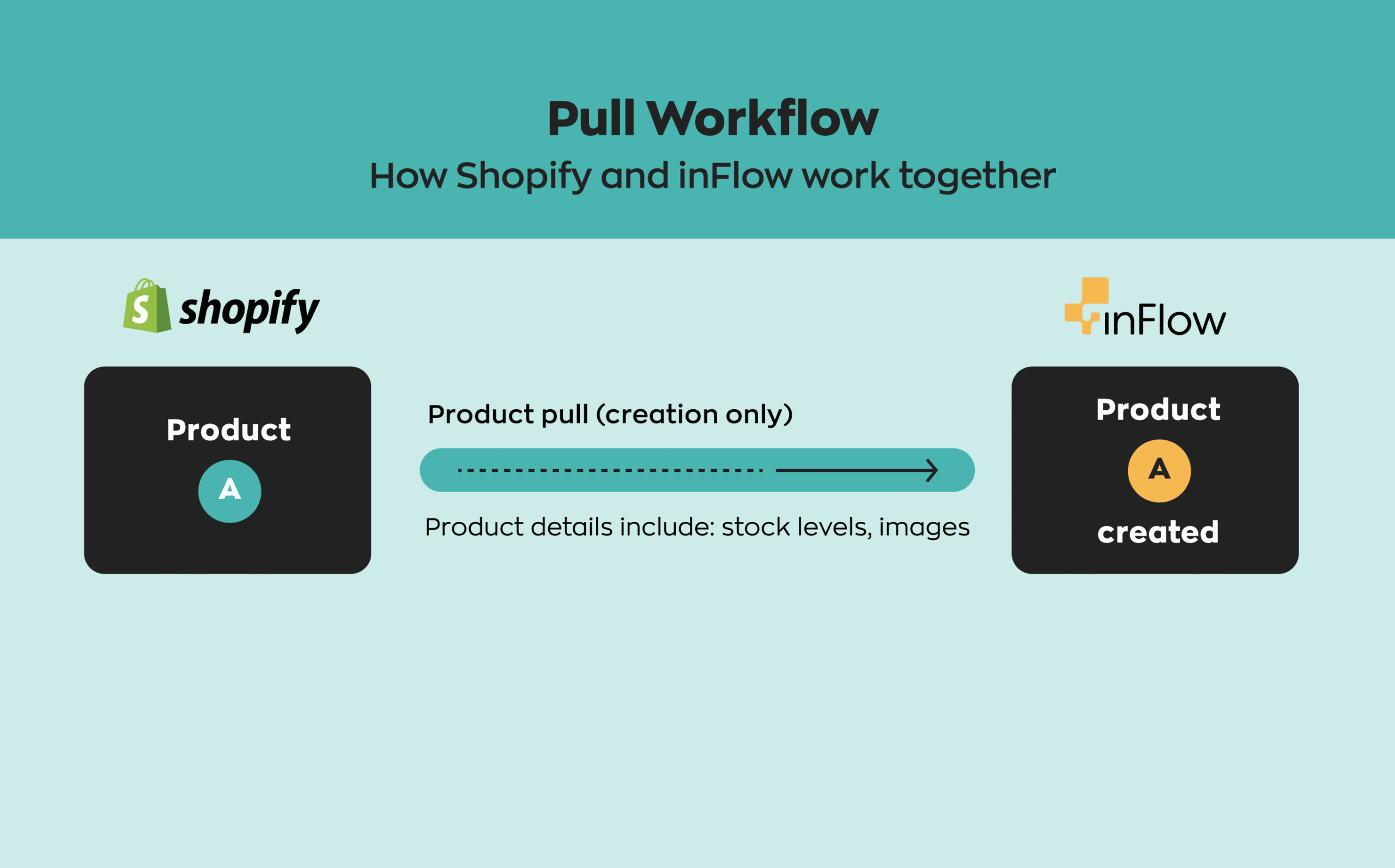
If you want to trigger a product pull from Shopify, you can do so with the Pull now button in the inFlow Connector app within the Shopify app’s integration settings.
- Go to https://app.inflowinventory.com/options/integrations.
- Click on the Shopify icon.
- Click on the blue arrow next to your Shopify store name.
- Click on the Product sync tab.
- In the Pull settings section, you will see when products were last pulled from Shopify. Click the Pull now button to start pulling product details from Shopify to inFlow.
What product information can inFlow pull from Shopify?
When the product pull settings are active, inFlow will connect to Shopify and automatically pull in any new products that have been made in Shopify. The details that will be created with the pull are
- Product name
- SKU
- Stock levels
- Images
- Barcode
- Weight
- Pricing.
This setting has a limitation where all products can be pulled from Shopify to inFlow only once per product.
Products pulled from Shopify will be created as stocked products.
Using FIFO/LIFO & connecting to Shopify
When using FIFO or LIFO costing in inFlow, products pulled from Shopify won’t pull the product costs. The costs are only updated when a purchase or manufacture order is created in inFlow.
Updated product costs in inFlow can then sync back to Shopify based on the cost push settings. You will receive an alert when products are pulled without a cost.
How inFlow connects to Shopify variant products
If your Shopify store offers products in various sizes or choices, you’ll want to review this section. inFlow tracks variants by using product groups, which serve as containers that include all the variant options.
inFlow has a one-way sync with Shopify product groups, meaning inFlow can pull these products, but it can’t push updates from the matching product group back to Shopify.
However, all variant option products that share a SKU with variant products in your Shopify store will sync together.
Shopify tracks variants in a similar manner, with a main product serving as a container to house all variant options and their corresponding product details and images. Each Shopify product variant can only have one associated product image, unlike the main product group/container.
When you update the product details for an inFlow product with a matching SKU of a Shopify variant, the change will only apply to that specific matching SKU. When the matching inFlow variant product pushes image updates to Shopify, both the matching variant product and the product group/container are updated.
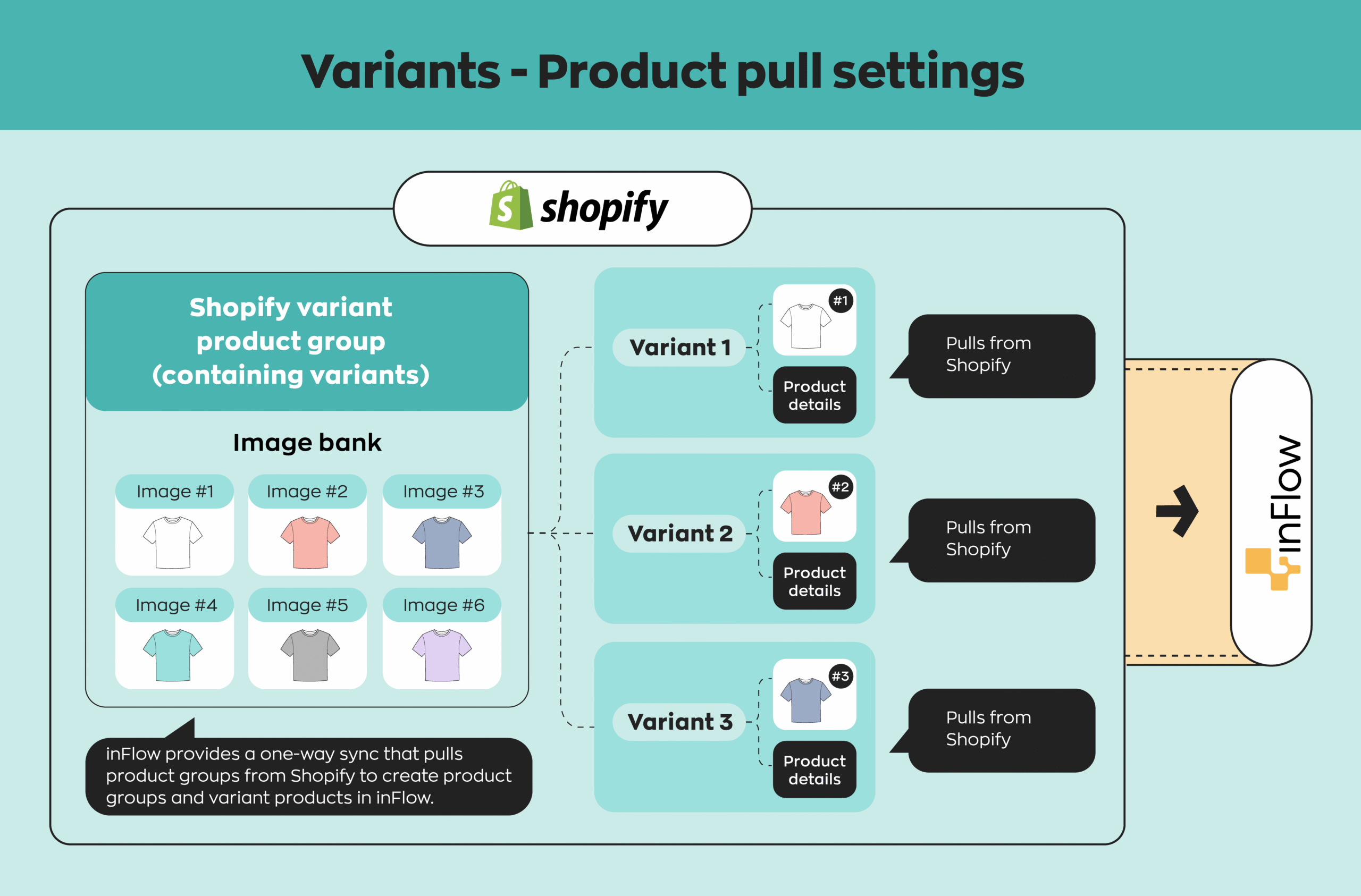
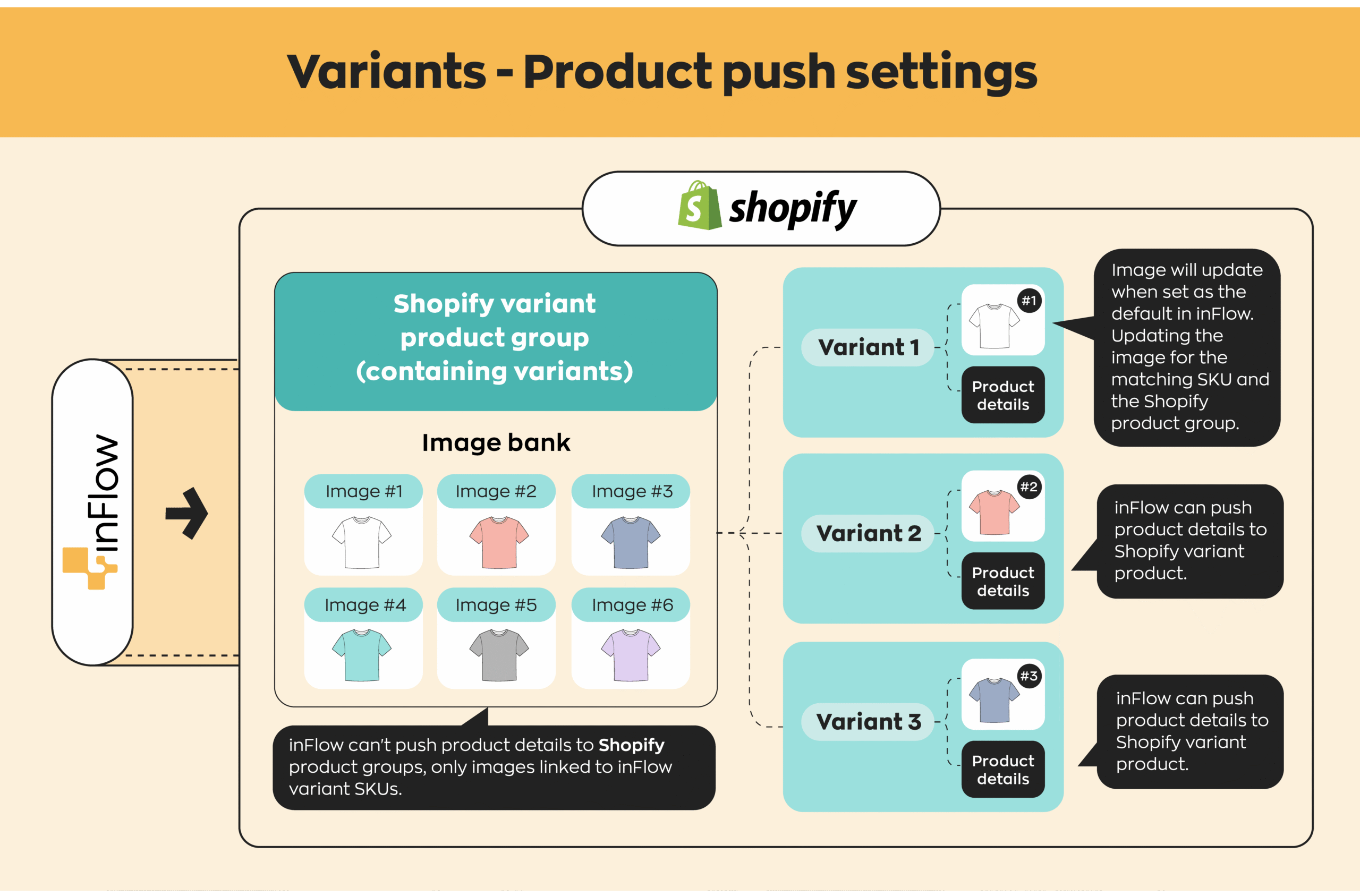
Additional information
Why isn’t there an option to update the description?
Currently, inFlow cannot update the description field for Shopify products. This is due to Shopify having different technical formatting on its description field compared to the inFlow description field.
Our aim with connecting inFlow to Shopify is to make things easier for you and your team. So by not syncing the description, it’ll avoid formatting troubles that could occur.
How will inFlow determine the stock level or quantity to push to Shopify?
inFlow syncs the quantity available based on purchase orders, sales orders, work orders, and stock adjustments that have been made. This only applies to products that exist in both inFlow and Shopify; having the Pull settings active can ensure that no products are missed from the Shopify side.
How will inFlow and Shopify handle pulling and pushing product costs?
As mentioned, products with matching SKUs can receive updates from inFlow pushed to Shopify. This is to reduce double entries for product updates.
The product cost field will do the same and update the matching SKU in Shopify. Changes made to the unit price on purchase orders or with manual entry changes on the product record will be sent over. Take a look at the following guide for how inFlow calculates cost.
How will inFlow handle different product weight units in Shopify?
When inFlow pushes updates to Shopify, if there’s a difference in units, then inFlow will push the weight units that are in inFlow to the matching SKU in Shopify.
When inFlow pulls a product from Shopify that has different weight units, then inFlow will convert the weight from what’s in Shopify to match the equivalent in inFlow.
Troubleshooting
I cleared fields on the inFlow product record, but the changes didn’t appear in Shopify. How come?
To make sure no data is erased or overwritten, inFlow won’t push blank data to Shopify. This means that if you need to clear any information, such as price or weight, you must make the changes in both inFlow and Shopify.
Orders from Shopify aren’t showing up in inFlow
If you have automatic archiving of orders enabled in Shopify, your Shopify orders will not be pulled into inFlow. To check and turn off this feature:
For details on Shopify’s automatic archiving of orders feature, please see Shopify’s documentation here.
- Log in to your Shopify account: https://accounts.shopify.com/store-login.
- Go to Settings > Checkout.
- Scroll to Order processing.
- Under “After an order has been fulfilled and paid,” uncheck the option to automatically archive the order.
Error in the Shopify App Store
If you are in the Shopify App Store and see the error that reads: app.inflowinventory.com refused to connect, you can still set up your integration without trouble. Simply access the inFlow Web app directly from app.inflowinventory.com to continue.
If you leave the setup idle, you may need to refresh or log back in to your Shopify store.
Products in Shopify aren’t updating
Check if the Shopify product SKU matches an inFlow product SKU. inFlow can only update products that have a matching SKU or product name.

0 Comments